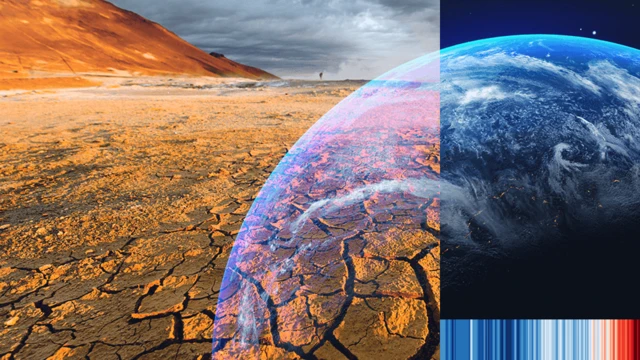The recent decision by CERN to initiate experimental endeavors aimed at elucidating the interactions between protons and climate phenomena has ignited a discourse rich with both anticipation and skepticism. Situated at the nucleus of fundamental particle physics, CERN—home to the Large Hadron Collider (LHC)—is not just pivotal for its contributions to our understanding of the universe but has now set its sights on an inquiry that juxtaposes the realm of subatomic particles against the very tangible issue of climate change. This intersection prompts a provocative question: Can the behavior of protons under high-energy conditions provide insight into the Earth’s climatic shifts, or are we treading into a domain where particle physics might not yield the answers we seek? The challenge lies in disentangling the complex web of variables that influence climate systems from those that are inherently fundamental to particle interactions.
The phrase “protons vs planet warming” emerges not as a straightforward dichotomy but rather as an intricate dance of elements that warrant careful examination. At its core, proton interactions via particle collisions can simulate conditions prevalent in various cosmic events. However, relating these high-energy phenomena to terrestrial climate dynamics invites skepticism. The fundamental challenge arises from the scale and nature of climate systems, which are governed by myriad factors including greenhouse gas emissions, solar radiation, ocean currents, and atmospheric chemistry, among others. The interplay of these elements dwarfs the localized observations made in particle physics laboratories.
Consider the nature of the experiments being conducted at CERN. By accelerating protons to near-light speeds and colliding them, scientists glean data on fundamental forces and particle interactions. These studies, while illuminating aspects of our physical universe, enable minimal direct correlation to climate change, a phenomenon inherently tied to large-scale ecological and anthropogenic mechanisms. Thus, the question shifts towards applicability: How does one translate insights gleaned from transient subatomic collisions into applicable knowledge that can address climactic transformation? Can these findings catalyze new paradigms in energy production and consumption or simply serve as an intellectual curiosity?
In pursuit of understanding the relationship between protons and climate change, researchers emphasize the necessity of interdisciplinary collaboration. The marriage of physics with climatology, environmental science, and technology can catalyze innovation. For instance, insights drawn from Quantum Chromodynamics, the theory depicting the strong interaction between quarks and gluons, may inspire novel computational models for climate systems. Such models could predict extreme weather events with greater precision, thereby allowing for enhanced preparedness strategies. Yet, this remains speculative, requiring rigorous validation through empirical research.
Moreover, the quest for effective climate action necessitates a balance between immediate practical solutions and expansive scientific inquiries. The urgent need to mitigate climate change implications has galvanized a plethora of approaches, from renewable energy development to carbon capture technologies. Therefore, as CERN ventures into this novel territory, a salient query remains: How do we prioritize research funding and intellectual resources in light of pressing climate calamity? Should our capacity to manipulate protons dictate our investigative focus, or do we require a paradigm shift towards more accessible, pragmatic solutions?
Integrating particle physics insights into a broader environmental context could yield bifocal benefits: advancing basic research while simultaneously addressing societal needs. An exploratory path might involve a new research framework that utilizes particle physics methodologies—such as particle detection and analysis—for environmental monitoring. This can enable researchers to utilize high-energy detectors fashioned for colliding particles to track atmospheric particles and pollutants, paving the way for sophisticated climate modeling. It opens avenues to harness data, align technical rigor with real-world applicability, and potentially alter our approach to climate resilience.
Yet, amid the enthusiasm, it is crucial to recognize the limitations and potential pitfalls of such an integration. The overreliance on advanced physics to decode climate phenomena may cloud our interpretation of simpler, more elementary ecological principles. The narrative of “protons vs planet warming” runs the risk of becoming a scientifically extravagant distraction unless it maintains a clear linkage to tangible climate outcomes. This requires a disciplined approach, ensuring that all contributions from CERN’s research intentionally align with actionable climate science, bridging the gap between theoretical exploration and ecological necessity.
As researchers embark on this multidisciplinary voyage, the climate battle under the vast dome of CERN serves as a litmus test for scientific inquiry in the modern era. The pursuit of knowledge may find itself intertwined with the exigencies of ecological responsibility. Can we constructively intertwine the precision of high-energy physics with the chaotic intricacies of climate science to foster a more sustainable future? The answer may reside not solely in the behavior of protons but in the collective cognitive resonance that sustains global dialogues on climate actions. This challenge not only paves the way for scientific advancements but also reflects the broader societal imperative to unite varied academic disciplines to combat one of the greatest existential threats of our time.
Ultimately, as CERN fires up its experiments, it stands at the frontier of two worlds—one comprised of the infinitesimally small, the other encompassing the vast, fragile planet we inhabit. The insights generated could either elucidate pathways toward mitigating climate change or serve as a stark reminder of the limits of our understanding amidst a pressing global crisis.












